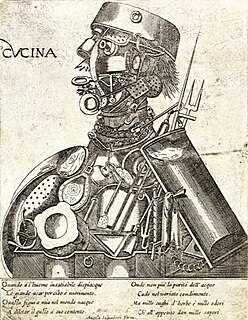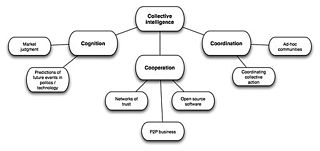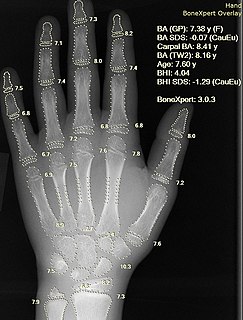Artificial intelligence (AI) is intelligence demonstrated by machines, as opposed to natural intelligence displayed by animals including humans. Leading AI textbooks define the field as the study of "intelligent agents": any system that perceives its environment and takes actions that maximize its chance of achieving its goals. Some popular accounts use the term "artificial intelligence" to describe machines that mimic "cognitive" functions that humans associate with the human mind, such as "learning" and "problem solving", however, this definition is rejected by major AI researchers.
The technological singularity—or simply the singularity—is a hypothetical point in time at which technological growth becomes uncontrollable and irreversible, resulting in unforeseeable changes to human civilization. According to the most popular version of the singularity hypothesis, called intelligence explosion, an upgradable intelligent agent will eventually enter a "runaway reaction" of self-improvement cycles, each new and more intelligent generation appearing more and more rapidly, causing an "explosion" in intelligence and resulting in a powerful superintelligence that qualitatively far surpasses all human intelligence.

Machine learning (ML) is the study of computer algorithms that can improve automatically through experience and by the use of data. It is seen as a part of artificial intelligence. Machine learning algorithms build a model based on sample data, known as training data, in order to make predictions or decisions without being explicitly programmed to do so. Machine learning algorithms are used in a wide variety of applications, such as in medicine, email filtering, speech recognition, and computer vision, where it is difficult or unfeasible to develop conventional algorithms to perform the needed tasks.

Dabbala Rajagopal "Raj" Reddy is an Indian-American computer scientist and a winner of the Turing Award. He is one of the early pioneers of artificial intelligence and has served on the faculty of Stanford and Carnegie Mellon for over 50 years. He was the founding director of the Robotics Institute at Carnegie Mellon University. He was instrumental in helping to create Rajiv Gandhi University of Knowledge Technologies in India, to cater to the educational needs of the low-income, gifted, rural youth. He is the chairman of International Institute of Information Technology, Hyderabad. He is the first person of Asian origin to receive the Turing Award, in 1994, known as the Nobel Prize of Computer Science, for his work in the field of artificial intelligence.
Collaborative intelligence characterizes multi-agent, distributed systems where each agent, human or machine, is autonomously contributing to a problem solving network. Collaborative autonomy of organisms in their ecosystems makes evolution possible. Natural ecosystems, where each organism's unique signature is derived from its genetics, circumstances, behavior and position in its ecosystem, offer principles for design of next generation social networks to support collaborative intelligence, crowdsourcing individual expertise, preferences, and unique contributions in a problem solving process.
Swarm intelligence (SI) is the collective behavior of decentralized, self-organized systems, natural or artificial. The concept is employed in work on artificial intelligence. The expression was introduced by Gerardo Beni and Jing Wang in 1989, in the context of cellular robotic systems.
The expression computational intelligence (CI) usually refers to the ability of a computer to learn a specific task from data or experimental observation. Even though it is commonly considered a synonym of soft computing, there is still no commonly accepted definition of computational intelligence.

The Wisdom of Crowds: Why the Many Are Smarter Than the Few and How Collective Wisdom Shapes Business, Economies, Societies and Nations, published in 2004, is a book written by James Surowiecki about the aggregation of information in groups, resulting in decisions that, he argues, are often better than could have been made by any single member of the group. The book presents numerous case studies and anecdotes to illustrate its argument, and touches on several fields, primarily economics and psychology.
In artificial intelligence research, commonsense knowledge consists of facts about the everyday world, such as "Lemons are sour", that all humans are expected to know. It is currently an unsolved problem in Artificial General Intelligence. The first AI program to address common sense knowledge was Advice Taker in 1959 by John McCarthy.

Intelligence amplification (IA) refers to the effective use of information technology in augmenting human intelligence. The idea was first proposed in the 1950s and 1960s by cybernetics and early computer pioneers.
Artificial intelligence, the intelligence exhibited by machines, has been used to develop thousands of applications to solve specific problems throughout industry and academia. It is an essential part of the most lucrative products in e-commerce. AI, like electricity or the steam engine, is a general purpose technology — there is no consensus on which tasks AI will excel at, now or in the future.

Artificial intelligence applications have been used in a wide range of fields including medical diagnosis, stock trading, robot control, law, scientific discovery, video games, and toys. However, many AI applications are not perceived as AI: "A lot of cutting edge AI has filtered into general applications, often without being called AI because once something becomes useful enough and common enough it's not labeled AI anymore." "Many thousands of AI applications are deeply embedded in the infrastructure of every industry." In the late 1990s and early 21st century, AI technology became widely used as elements of larger systems, but the field was rarely credited for these successes at the time.

Collective intelligence (CI) is shared or group intelligence that emerges from the collaboration, collective efforts, and competition of many individuals and appears in consensus decision making. The term appears in sociobiology, political science and in context of mass peer review and crowdsourcing applications. It may involve consensus, social capital and formalisms such as voting systems, social media and other means of quantifying mass activity. Collective IQ is a measure of collective intelligence, although it is often used interchangeably with the term collective intelligence. Collective intelligence has also been attributed to bacteria and animals.

Artificial intelligence in healthcare is an overarching term used to describe the use of machine-learning algorithms and software, or artificial intelligence (AI), to mimic human cognition in the analysis, presentation, and comprehension of complex medical and health care data. Specifically, AI is the ability of computer algorithms to approximate conclusions based solely on input data.
Explainable AI (XAI) is artificial intelligence (AI) in which the results of the solution can be understood by humans. It contrasts with the concept of the "black box" in machine learning where even its designers cannot explain why an AI arrived at a specific decision. XAI may be an implementation of the social right to explanation. XAI is relevant even if there is no legal right or regulatory requirement—for example, XAI can improve the user experience of a product or service by helping end users trust that the AI is making good decisions. This way the aim of XAI is to explain what has been done, what is done right now, what will be done next and unveil the information the actions are based on. These characteristics make it possible (i) to confirm existing knowledge (ii) to challenge existing knowledge and (iii) to generate new assumptions.
The Artificial Intelligence of Things (AIoT) is the combination of Artificial intelligence (AI) technologies with the Internet of things (IoT) infrastructure to achieve more efficient IoT operations, improve human-machine interactions and enhance data management and analytics.
Artificial intelligence (AI) in hiring involves the use of technology to automate aspects of the hiring process. Advances in artificial intelligence, such as the advent of machine learning and the growth of big data, enable AI to be utilized to recruit, screen, and predict the success of applicants. Proponents of artificial intelligence in hiring claim it reduces bias, assists with finding qualified candidates, and frees up human resource workers' time for other tasks, while opponents worry that AI perpetuates inequalities in the workplace and will eliminate jobs.

Spatial embedding is one of feature learning techniques used in spatial analysis where points, lines, polygons or other spatial data types. representing geographic locations are mapped to vectors of real numbers. Conceptually it involves a mathematical embedding from a space with many dimensions per geographic object to a continuous vector space with a much lower dimension.
Human-AI collaboration is the study of how humans and artificial intelligence (AI) agents work together to accomplish a shared goal. AI systems can aid humans in everything from decision making tasks to art creation. Examples of collaboration include medical decision making aids., hate speech detection, and music generation. As AI systems are able to tackle more complex tasks, studies are exploring how different models and explanation techniques can improve human-AI collaboration.
Predictive policing refers to the usage of mathematical, predictive analytics, and other analytical techniques in law enforcement to identify potential criminal activity. A report published by the RAND Corporation identified four general categories predictive policing methods fall into: methods for predicting crimes, methods for predicting offenders, methods for predicting perpetrators' identities, and methods for predicting victims of crime.








